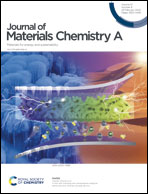Tuning atomically precise metal nanocluster mediated photoelectrocatalysis via a non-conjugated polymer†
Abstract
In recent years, atomically precise metal nanoclusters (NCs) have demonstrated fascinating applicability in solar energy conversion due to their unique atomic stacking arrangements, quantum size effect and abundant active sites. Nevertheless, ultra-short carrier lifetimes and poor stabilities impede the construction of robust metal-NC-based photosystems. Herein, positively charged poly(diallyl-dimethylammonium chloride) (PDDA) and tailor-made negatively charged L-glutathione (GSH)-capped Agx@GSH [Ag9(SG)6, Ag16(SG)9 and Ag31(SG)19] NCs are used as building blocks and alternately deposited on a one-dimensional wide-band-gap metal oxide (MO) substrate using a facile and general layer-by-layer (LbL) assembly strategy to design a highly efficient spatially directional charge transport pathway in multilayered photoanodes. The electrons photoexcited from the periodically stacked Agx@GSH [Ag9(SG)6, Ag16(SG)9 and Ag31(SG)19] NC layers concurrently and unidirectionally migrate to the MO substrate, while the ultrathin PDDA intermediate layer serves as an interfacial electron-withdrawing charge mediator to accelerate the transport of the carriers photoexcited over the neighboring Agx@GSH [Ag9(SG)6, Ag16(SG)9 and Ag31(SG)19] NC layers. Benefiting from the charge transfer enhancement, these LbL-assembled multilayered MO/(PDDA/Agx NCs)n heterostructured photoanodes demonstrate significantly enhanced photoelectrochemical water oxidation performance under visible light irradiation due to the generation of unidirectional and spatially separated tandem charge transfer channels, which remarkably reduces the charge recombination and prolongs the carrier lifetime of the metal NCs. Moreover, we ascertain that this conceptual multilayered nanoarchitecture design and tandem charge transport are universal.



 Please wait while we load your content...
Please wait while we load your content...